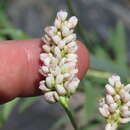fi
nimet breadcrumb-navigoinnissa


Polygonum pensylvanicum (lat. Polygonum pensylvanicum) - qırxbuğumkimilər fəsiləsinin qırxbuğum cinsinə aid bitki növü.
Polygonum pensylvanicum (lat. Polygonum pensylvanicum) - qırxbuğumkimilər fəsiləsinin qırxbuğum cinsinə aid bitki növü.
Planhigyn blodeuol cosmopolitan, lluosflwydd yw Y ganwraidd rosliw sy'n enw benywaidd. Mae'n perthyn i'r teulu Polygonaceae. Yr enw gwyddonol (Lladin) yw Persicaria pensylvanica a'r enw Saesneg yw Pinkweed.[1] Ceir enwau Cymraeg eraill ar y planhigyn hwn gan gynnwys Pinclys.
Mae hefyd yn blanhigyn bytholwyrdd.
Planhigyn blodeuol cosmopolitan, lluosflwydd yw Y ganwraidd rosliw sy'n enw benywaidd. Mae'n perthyn i'r teulu Polygonaceae. Yr enw gwyddonol (Lladin) yw Persicaria pensylvanica a'r enw Saesneg yw Pinkweed. Ceir enwau Cymraeg eraill ar y planhigyn hwn gan gynnwys Pinclys.
Mae hefyd yn blanhigyn bytholwyrdd.
Persicaria pensylvanica (syn. Polygonum pensylvanicum[1]) is a species of flowering plant in the buckwheat family, Polygonaceae. It is native to parts of North America, where it is widespread in Canada and the United States.[2] It has also been noted as an introduced species in parts of Europe and South America.[3] Common names include Pennsylvania smartweed and pinkweed.[2]
Pennsylvania smartweed is a variable annual herb reaching 10 cm (3.9 in) to 2 m (6.6 ft) tall. The upright, ribbed stems are branching or unbranched. The lance-shaped leaves reach up to about 2 cm (0.79 in) in length. The blade may be marked with a dark blotch. The brownish ochrea at the base is up to 2 cm (0.79 in). The inflorescences grow at the top of the stem and from the leaf axils. The flowers have five pinkish or greenish tepals each a few millimeters long.[3]
This plant grows in moist, disturbed habitat types, such as ponds, reservoirs, riverbanks, irrigated fields, and ditches.[3]
This plant is an important part of the habitat for waterfowl and other birds, which use it for food and cover. At least 50 species of birds have been observed feeding on the seeds, including ducks, geese, rails, bobwhites, mourning dove, and ring-necked pheasant. The seeds and other parts are eaten by mammals such as the white-footed mouse, muskrat, raccoon, and fox squirrel.[4]
Native Americans have various uses for the plant. The Chippewa use it for epilepsy.[5][6] The Iroquois use it for horse colic.[5][7] The Menominee take a leaf infusion for hemorrhage of blood from the mouth and post-partum healing.[5][8] The Meskwaki use it on bleeding hemorrhoids.[5][9]
Persicaria pensylvanica (syn. Polygonum pensylvanicum) is a species of flowering plant in the buckwheat family, Polygonaceae. It is native to parts of North America, where it is widespread in Canada and the United States. It has also been noted as an introduced species in parts of Europe and South America. Common names include Pennsylvania smartweed and pinkweed.
Persicaria pensylvanica (anciennement Polygonum pensylvanicum), la Renouée de Pennsylvanie est une espèce de renouée du genre Persicaria. On la trouve aux abords du fleuve Saint-Laurent au Québec. Doit être placée à un endroit où il y a du soleil direct au moins quelques heures. Au moins 15 °C. Peut pousser sur tourbe, sable, terreau, ponce, écorce et substances organiques. Mettre de l'engrais aux environs des 20-25 jours.
Persicaria pensylvanica (anciennement Polygonum pensylvanicum), la Renouée de Pennsylvanie est une espèce de renouée du genre Persicaria. On la trouve aux abords du fleuve Saint-Laurent au Québec. Doit être placée à un endroit où il y a du soleil direct au moins quelques heures. Au moins 15 °C. Peut pousser sur tourbe, sable, terreau, ponce, écorce et substances organiques. Mettre de l'engrais aux environs des 20-25 jours.
Persicaria pensylvanica là một loài thực vật có hoa trong họ Rau răm. Loài này được (L.) M. Gómez miêu tả khoa học đầu tiên năm 1896.[1]
Persicaria pensylvanica là một loài thực vật có hoa trong họ Rau răm. Loài này được (L.) M. Gómez miêu tả khoa học đầu tiên năm 1896.